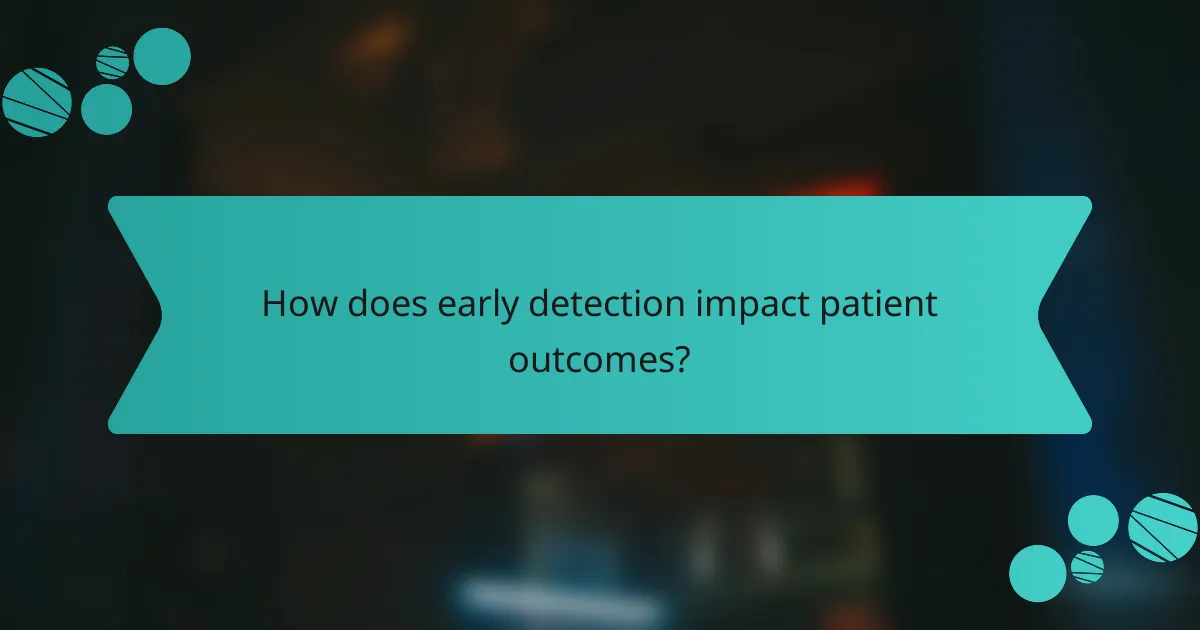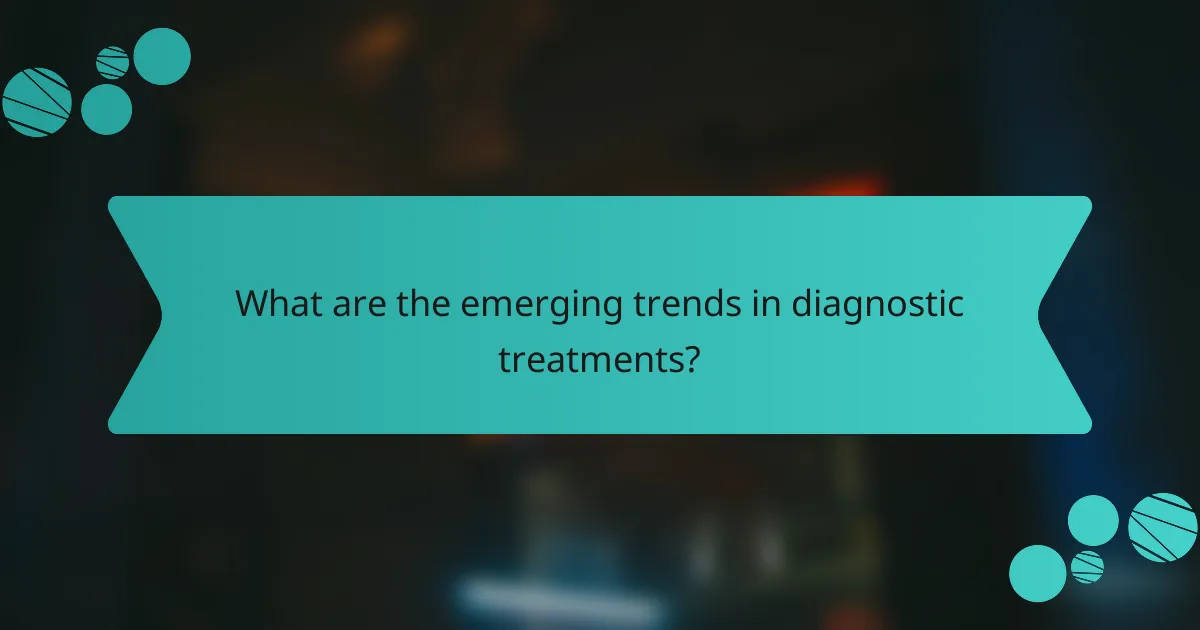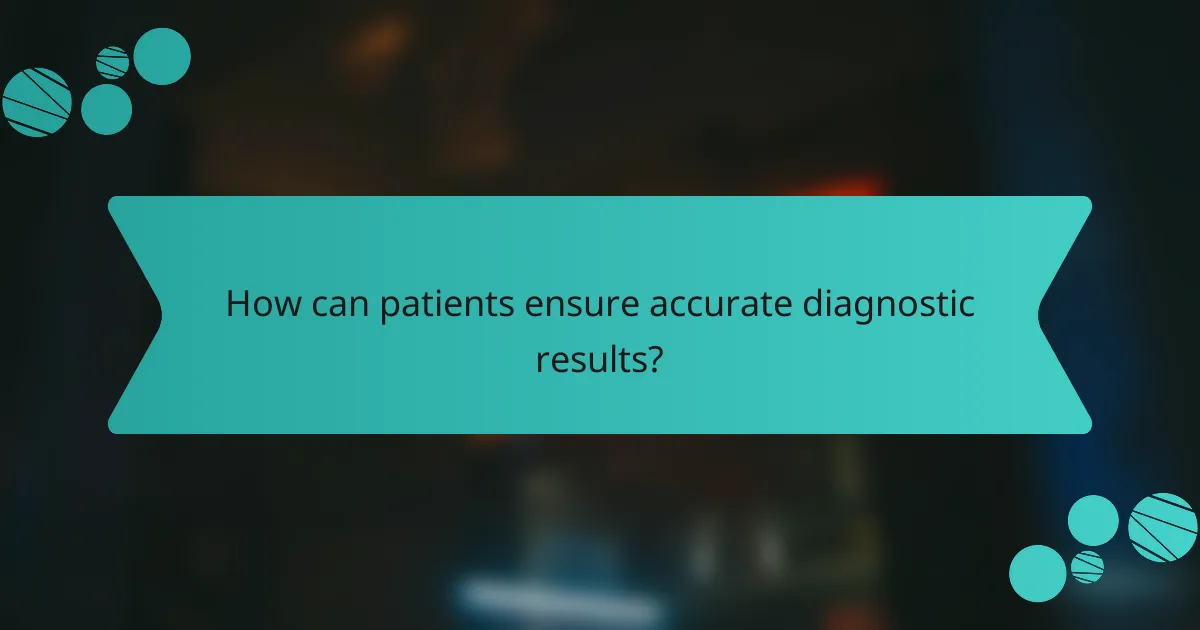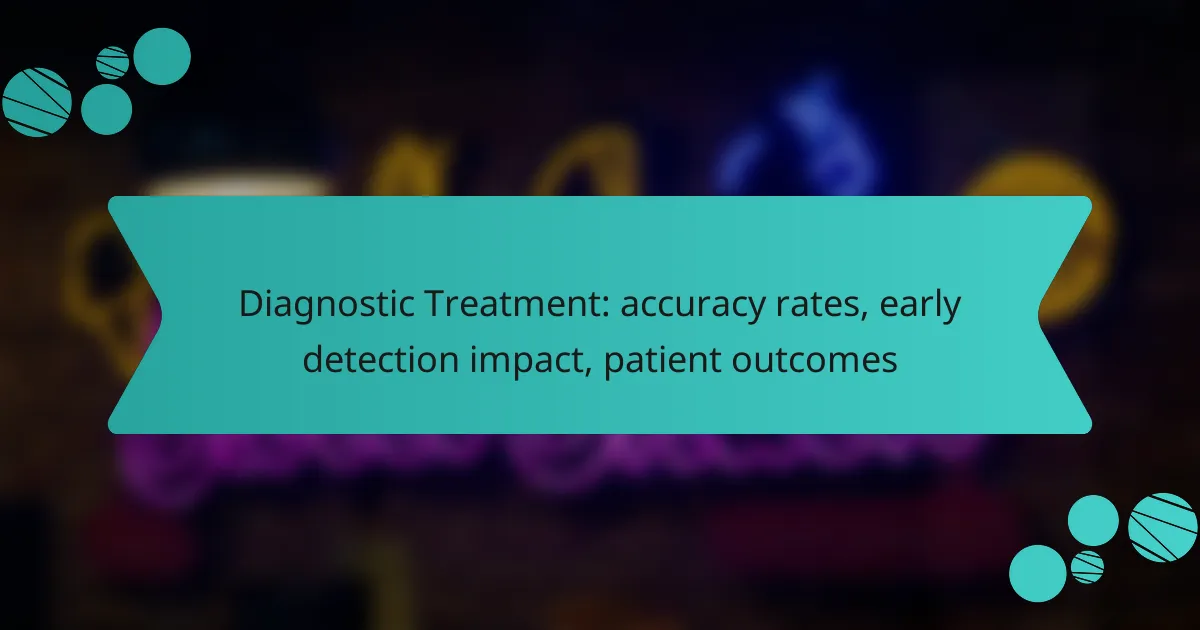Diagnostic treatments play a crucial role in healthcare, with accuracy rates varying significantly across different methods. Early detection through these diagnostics not only improves patient outcomes by identifying diseases at more manageable stages but also contributes to better survival rates and reduced treatment costs.

What are the accuracy rates of diagnostic treatments in Canada?
In Canada, the accuracy rates of diagnostic treatments vary significantly depending on the method used. Imaging techniques generally exhibit high accuracy, while laboratory tests can show more variability in results.
High accuracy in imaging techniques
Imaging techniques such as MRI, CT scans, and ultrasounds are known for their high accuracy rates, often exceeding 90% in detecting various conditions. These methods provide detailed visualizations that help clinicians make informed decisions quickly.
For instance, MRI is particularly effective in diagnosing neurological conditions, while CT scans are commonly used for trauma assessments. The precision of these imaging modalities contributes to early detection and improved patient outcomes.
Variability in laboratory tests
Laboratory tests, including blood tests and biopsies, can exhibit significant variability in accuracy rates, often ranging from 70% to 90%. Factors such as sample handling, testing methods, and laboratory standards can influence these results.
For example, a common blood test for thyroid function may yield different results based on the laboratory’s protocols. This variability underscores the importance of using accredited laboratories and standardized procedures to enhance reliability.
Factors affecting accuracy rates
Several factors can affect the accuracy rates of diagnostic treatments, including patient demographics, the skill of the technician, and the technology used. Age, gender, and underlying health conditions can influence how well a diagnostic test performs.
Additionally, the experience of the healthcare provider interpreting the results plays a crucial role. Continuous training and adherence to best practices can help mitigate inaccuracies and improve diagnostic outcomes.

How does early detection impact patient outcomes?
Early detection significantly enhances patient outcomes by identifying diseases at more treatable stages. This proactive approach leads to better survival rates, lower treatment costs, and improved quality of life for patients.
Improved survival rates
Detecting diseases early often results in higher survival rates, as treatments can be initiated before conditions progress. For instance, early-stage cancers typically have a much better prognosis compared to late-stage diagnoses.
Studies indicate that early detection can improve survival rates by a substantial margin, often exceeding 50% in certain cancers. Regular screenings and awareness of symptoms are crucial for achieving these outcomes.
Reduced treatment costs
Early detection can lead to significantly reduced treatment costs by minimizing the need for extensive interventions. When diseases are caught early, treatments are often less invasive and require shorter hospital stays.
For example, treating early-stage cancer may involve outpatient procedures rather than costly surgeries and prolonged chemotherapy. This not only saves money for patients but also alleviates the financial burden on healthcare systems.
Enhanced quality of life
Patients diagnosed early often experience a better quality of life due to less aggressive treatments and fewer side effects. Early intervention allows for more effective management of symptoms and overall health.
Moreover, patients can maintain their daily activities and emotional well-being when diseases are managed promptly. This holistic approach to health care emphasizes the importance of regular check-ups and awareness of health changes.

What diagnostic treatments are commonly used in Canada?
In Canada, several diagnostic treatments are widely utilized to detect and monitor various health conditions. These include advanced imaging techniques and laboratory tests that help clinicians make informed decisions about patient care.
Magnetic Resonance Imaging (MRI)
Magnetic Resonance Imaging (MRI) is a non-invasive imaging technique that uses strong magnets and radio waves to create detailed images of organs and tissues. It is particularly effective for diagnosing conditions related to the brain, spinal cord, and joints.
When considering an MRI, patients should be aware of the time commitment, as scans can take anywhere from 15 minutes to over an hour. Additionally, patients with metal implants or certain medical devices may need to consult their doctor before undergoing this procedure.
Computed Tomography (CT) scans
Computed Tomography (CT) scans combine X-ray images taken from different angles to produce cross-sectional views of the body. This method is useful for quickly diagnosing injuries, tumors, and internal bleeding.
CT scans are generally faster than MRIs, often completed in just a few minutes. However, they do expose patients to a small amount of radiation, which is a consideration for repeated scans. Patients should discuss the risks and benefits with their healthcare provider.
Blood tests for early detection
Blood tests play a crucial role in the early detection of various diseases, including cancers and metabolic disorders. These tests can measure specific biomarkers that indicate the presence of disease, allowing for timely intervention.
Common blood tests include complete blood counts (CBC), liver function tests, and specific tumor markers. Patients should consult their healthcare provider to determine which tests are appropriate based on their health history and risk factors.

What criteria should be considered when choosing diagnostic treatments?
When selecting diagnostic treatments, it is essential to consider patient health history, the type of suspected condition, and the availability of technology. These factors significantly influence the accuracy of diagnoses and the effectiveness of subsequent treatments.
Patient health history
Understanding a patient’s health history is crucial in choosing appropriate diagnostic treatments. Factors such as previous illnesses, family medical history, and current medications can affect the likelihood of certain conditions and the effectiveness of specific tests.
For instance, a patient with a family history of cardiovascular disease may warrant more aggressive screening for heart-related conditions. Additionally, allergies to contrast agents used in imaging should be noted to avoid adverse reactions.
Type of suspected condition
The suspected condition plays a vital role in determining which diagnostic treatments to pursue. Different conditions may require specific tests that have varying levels of sensitivity and specificity.
For example, if cancer is suspected, imaging techniques like MRI or CT scans may be prioritized due to their ability to provide detailed images of internal structures. Conversely, for infections, blood tests or cultures might be more appropriate for accurate diagnosis.
Availability of technology
The availability of diagnostic technology can significantly impact the choice of treatment. Access to advanced imaging or laboratory facilities may vary by region, affecting the options available to healthcare providers.
In urban areas, patients may have access to cutting-edge diagnostic tools, while those in rural locations might rely on more traditional methods. It’s essential to consider local resources and the potential need for referrals to specialized centers when selecting diagnostic treatments.

What are the emerging trends in diagnostic treatments?
Emerging trends in diagnostic treatments focus on enhancing accuracy rates, improving early detection, and ultimately boosting patient outcomes. Innovations such as artificial intelligence, personalized medicine, and telemedicine are reshaping how diagnostics are approached and delivered.
Artificial Intelligence in diagnostics
Artificial intelligence (AI) is revolutionizing diagnostics by analyzing vast amounts of data quickly and accurately. AI algorithms can identify patterns that may be missed by human clinicians, leading to earlier and more precise diagnoses.
For instance, AI tools are increasingly used in radiology to detect anomalies in imaging studies, achieving accuracy rates that can exceed traditional methods. These technologies can significantly reduce the time required for diagnosis, often providing results in a matter of minutes.
Personalized medicine approaches
Personalized medicine tailors diagnostic treatments to individual patient profiles, including genetic, environmental, and lifestyle factors. This approach enhances the effectiveness of treatments by ensuring that patients receive therapies that are most likely to work for their specific conditions.
For example, genetic testing can guide oncologists in selecting targeted therapies for cancer patients, improving outcomes by focusing on the most effective treatment options. This trend is supported by the growing availability of genomic data and advancements in biotechnology.
Telemedicine for remote diagnostics
Telemedicine facilitates remote diagnostics, allowing patients to receive care without needing to visit a healthcare facility. This trend has gained momentum, especially in rural areas where access to specialists may be limited.
Through virtual consultations, healthcare providers can evaluate symptoms, order tests, and provide diagnoses from a distance. This not only saves time but also reduces the burden on healthcare systems, making it easier for patients to receive timely care.

How can patients ensure accurate diagnostic results?
Patients can ensure accurate diagnostic results by actively engaging with their healthcare process. This includes consulting specialized providers and seeking second opinions when necessary to confirm diagnoses and treatment plans.
Consulting specialized healthcare providers
Consulting specialized healthcare providers is crucial for obtaining accurate diagnostic results. These professionals have advanced training and expertise in specific areas, which can lead to more precise assessments and tailored treatment options.
For example, if a patient has symptoms related to a rare condition, seeing a specialist who focuses on that area can significantly improve diagnostic accuracy. Patients should consider asking their primary care physician for referrals to specialists when facing complex health issues.
Seeking second opinions
Seeking second opinions can be an effective strategy for ensuring diagnostic accuracy. Patients should not hesitate to consult another healthcare provider to confirm or challenge an initial diagnosis, especially if the proposed treatment is invasive or costly.
When seeking a second opinion, patients should provide the new provider with all relevant medical records and test results. This transparency helps the second provider make an informed assessment. Many insurance plans cover second opinions, so patients should check their policy to understand their options.
